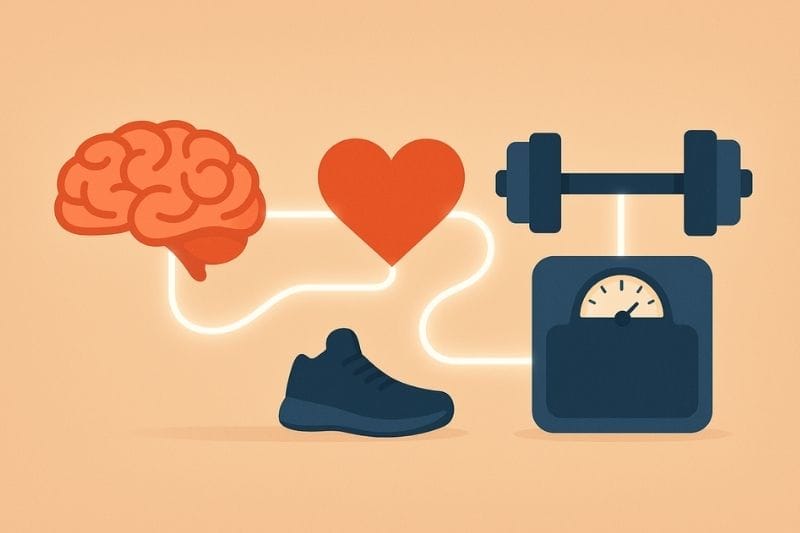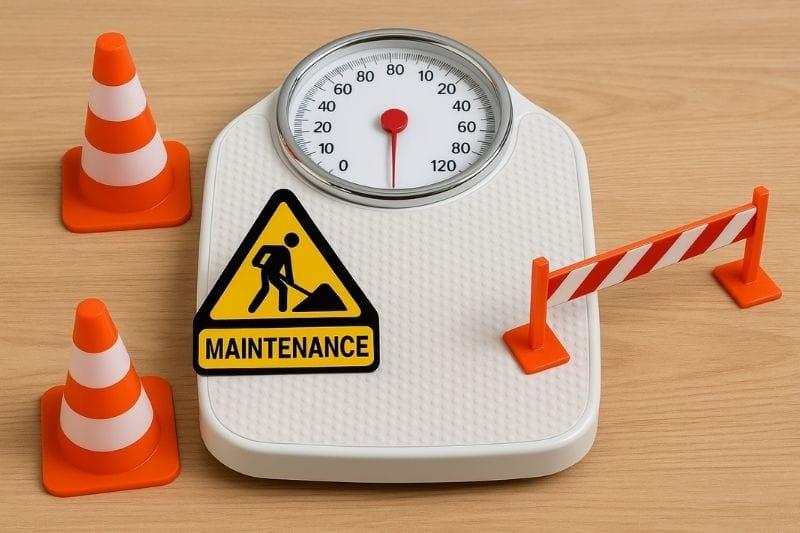How can I stop feeling hungry when on a diet?
Feeling hungry all the time is a challenge for many people when trying to lose weight, and something I often chat about with my online weight loss coaching clients. You start with good intentions, but constant cravings and rumbling stomachs make everything feel like an uphill battle. It’s frustrating, it’s tiring, and it’s one of the biggest reasons people give up on diets altogether.
The good news is that there is a way to manage your appetite without living on tiny portions or cutting out all your favourite foods. It’s called volume eating, and it can make a calorie deficit feel far more manageable. Instead of focusing on restriction, it focuses on the types of foods that keep you feeling satisfied for longer. Once you understand how it works, it can be a genuine game changer for weight loss.
Volume eating is not a strict diet or a set of complicated rules. It’s a practical strategy that makes use of basic nutrition principles in a way that fits your life. If you’ve ever looked at a plate of food and thought, “That’s not going to fill me up,” then this approach is worth exploring.
What Is Volume Eating?
Volume eating is about choosing foods that give you more to eat for fewer calories. It focuses on building meals with ingredients that are naturally lower in calories but higher in water and fibre. These foods take up more space in your stomach, which helps you feel full and satisfied without overshooting your calorie goals.
Typical examples include fruit, vegetables, lean proteins, grains, soups and salads. Think of a large bowl of vegetable soup or a plate loaded with roasted vegetables and chicken. These meals are often lower in calories than a pastry or a chocolate bar, but they keep you full for much longer.
It’s not about piling your plate sky high for the sake of it. The idea is to combine sensible portions with clever food choices so that your meals feel substantial and satisfying. Over time, this makes it easier to stick to a calorie deficit without feeling like you’re constantly battling hunger.
Why Volume Eating Works For Weight Loss
The main reason volume eating works is because it makes controlling your appetite feel natural rather than forced. When you’re not constantly hungry, you make better decisions and find it easier to stay consistent.
Foods that are high in water and fibre add bulk to your meals without adding many calories. You can eat generous portions, which helps your brain register that you’ve had a proper meal. This feeling of fullness lasts longer, which means fewer snacks and less temptation later in the day.
It’s also a more sustainable approach than extreme restriction. You’re not relying on willpower alone to get through the day. Instead, you’re setting yourself up to feel satisfied, which is what makes the difference between a short term diet and long term progress.
Practical Tips For Volume Eating
The easiest way to get started is by making small, manageable tweaks rather than trying to change everything at once. A few adjustments to how you build your meals can have a big impact.
Adding extra vegetables or salad to your main meals is one of the simplest ways to increase volume without adding many calories. Even a handful of leafy greens or chopped veg can make a meal feel more substantial.
Choosing lean protein such as chicken, turkey, eggs, white fish or cottage cheese helps keep meals satisfying. Protein plays a big role in helping you feel full, so combining it with high volume foods works well.
Soups, stews and stir fries are naturally high in volume and easy to pack with nutrients. They’re also a great way to use up leftovers and add variety.
Swapping calorie dense sauces and snacks for lighter alternatives like tomato based sauces or salsa can make a big difference too. These little changes can quietly save you hundreds of calories over a week.
It’s also worth keeping an eye on oils, dressings and toppings. A drizzle here and there can add up quickly, so using them more mindfully can keep your calorie intake on track.
Best Foods For Volume Eating
Some foods naturally lend themselves to volume eating better than others. Focusing on these can make your meals more filling and easier to manage.
- Fruit such as apples, berries and oranges
- Leafy greens and most vegetables including courgettes, peppers, mushrooms and carrots
- Lean proteins like chicken, turkey, eggs, white fish and cottage cheese
- Broth based soups and lighter grain dishes like rice or quinoa in sensible amounts
A good mix of these foods gives you meals that feel generous and satisfying while keeping your calories under control. It also adds a lot of variety and colour to your diet, which makes healthy eating more enjoyable.
Some Example Volume Eating Meals:
- Chicken and Vegetable Stir Fry with Rice – Ingredients (serves 1):
- 120g chicken breast, sliced
- 150g mixed stir fry vegetables (carrots, cabbage, beansprouts, peppers)
- 100g cooked basmati rice
- 1 tsp olive oil
- Soy sauce, garlic, and ginger to taste
Why it works:
The large volume of mixed vegetables and rice adds bulk without many calories, creating a high-volume meal that feels substantial.
Approximate nutrition: 480 kcal, 40g protein, 6g fibre (these will vary with brands, so estimates only)
- High Volume Pasta Bowl – Ingredients (serves 1):
- 75g wholewheat pasta
- 120g extra lean beef mince or turkey mince
- 200g tinned chopped tomatoes
- 100g courgette, 100g mushrooms, 100g peppers, chopped
- Herbs, garlic, and black pepper
Why it works:
The vegetables more than double the portion size without adding many calories. You get a big bowl of food that’s filling, rich in fibre and still moderate in calories.
Approximate nutrition: 550 kcal, 42g protein, 10g fibre (these will vary with brands, so estimates only)
- Loaded Jacket Potato with Cottage Cheese and Salad – Ingredients (serves 1):
- 1 medium baking potato (about 250g)
- 150g low fat cottage cheese
- 1 large tomato, diced
- ¼ cucumber, chopped
- Mixed salad leaves
Why it works:
Adding a generous side of salad and using a high-fibre potato skin increases the food volume while keeping calories low.
Approximate nutrition: 480 kcal, 35g protein, 8g fibre (these will vary with brands, so estimates only)
- Prawn and Vegetable Curry with Cauliflower Rice – Ingredients (serves 1):
- 150g king prawns
- 200g mixed vegetables (peas, carrots, peppers, spinach)
- 150g cauliflower rice
- 1 tbsp light curry paste
- 100ml light coconut milk
Why it works:
Cauliflower rice and a large portion of vegetables create a generous meal that’s light in calories but dense in nutrients and fibre.
Approximate nutrition: 430 kcal, 38g protein, 7g fibre (these will vary with brands, so estimates only)
- Breakfast Scramble with Eggs and Vegetables – Ingredients (serves 1):
- 2 large eggs + 2 egg whites
- 100g mushrooms
- 100g tomatoes
- 50g spinach
- 1 slice wholemeal toast
Why it works:
Adding a large portion of vegetables bulks up the meal and keeps you full for longer without many extra calories, showing how volume eating works even at breakfast.
Approximate nutrition: 410 kcal, 33g protein, 5g fibre (these will vary with brands, so estimates only)
Common Mistakes To Avoid
Volume eating works best when it’s balanced. A few common mistakes can get in the way of your progress if you’re not careful.
One mistake is relying too heavily on vegetables without including enough protein. While veg is great for adding bulk, it won’t keep you full for long on its own. Another is thinking that healthy foods can be eaten in unlimited amounts. Even lower calorie foods can add up if you eat very large portions.
Sauces, oils and toppings are another easy trap. They seem harmless in small amounts but can quietly turn a healthy meal into a calorie dense one. Finally, using volume eating as an excuse to binge on “good” foods can backfire. The goal is to work with your hunger cues, not override them.
Volume Eating FAQs
Can you lose weight with volume eating?
Yes. Volume eating makes it easier to create a calorie deficit without feeling hungry all the time. By choosing lower calorie foods that fill you up, you can stick to your plan more consistently.
Are grapes good for volume eating?
Grapes are healthy and refreshing but they’re higher in natural sugars than some other fruits. A handful is fine, but they’re not as filling as apples or berries, so it’s easy to eat a lot without realising.
Are potatoes good for volume eating?
Yes, when cooked simply. Boiled or baked potatoes are filling and relatively low in calories for their size. It’s usually the added butter, cheese or oil that pushes the calories up.
What are the best foods for volume eating?
The best options are high in water and fibre. Think fruit, vegetables, lean protein, soups and salads. These foods keep you full for longer and let you eat generous portions without too many calories.
How does volume eating work?
Volume eating works by increasing the size of your meals with low calorie foods. This fills your stomach and helps your brain register fullness, so you naturally eat less without feeling deprived.
How do I start volume eating?
Start by adding more fruit and vegetables to your meals and choosing lean proteins. Build your plate so that the bulk comes from lower calorie foods. You don’t need to be perfect. Small changes make a difference.
Can you eat bread and still do volume eating?
Yes. Bread can fit into volume eating if the rest of your meal is balanced. A sandwich with lots of salad and lean protein is a good example. Just be mindful of portion sizes and high calorie spreads.
Is volume eating healthy long term?
Yes, for most people it is. It encourages more fruit and vegetables, lean protein and high fibre foods, which support good health. As with any approach, balance matters and it should fit your lifestyle.
Making Volume Eating Work For You
Volume eating is a simple and realistic way to manage hunger while losing weight. By focusing on the types of foods you choose, you can eat satisfying meals, feel fuller for longer and stick to your goals without feeling restricted. All awesome for sustainable weight management!
If you want support putting a plan together that actually fits your life, my weight loss coaching can help you create structure and stay consistent.




